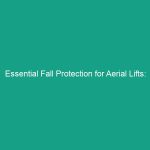Introduction
Health, Safety, and Environment (HSE) practices are crucial components of any workplace. They ensure that employees work in a safe environment, reducing the risk of accidents and injuries. One of the most common types of workplace accidents is falls, particularly in office settings. These incidents can lead to serious injuries, impacting not only the health of employees but also the productivity of the organization. In this article, we will explore essential tips to prevent falls in the office, ensuring a safer workplace for everyone.
Understanding the Regulatory Frameworks
In order to mitigate risks associated with falls in the workplace, understanding the regulatory frameworks governing Workplace Safety is essential. Regulatory bodies such as the Occupational Safety and Health Administration (OSHA) provide guidelines and Standards to minimize Hazards.
osha Standards
OSHA sets forth Regulations that require employers to maintain a safe working environment. These regulations include requirements for proper Maintenance of walking surfaces, slip-resistant flooring, and adequate lighting. Employers must also provide proper Training for employees regarding Safe Practices while navigating the office environment.
Other Regulatory Bodies
In addition to OSHA, other organizations such as the National Institute for Occupational Safety and Health (NIOSH) and various local Safety boards contribute to Workplace Safety regulations. Employers should be aware of these regulations to ensure compliance and to foster a safe workplace.
Best Practices for Fall Prevention
Implementing Best Practices is key to minimizing the risk of falls in the office. Here are several strategies that organizations can adopt:
1. Regular Maintenance of Workspaces
Regularly inspecting and maintaining workspaces can prevent Hazards that lead to falls. This includes ensuring that floors are clean and dry, and that any spills are promptly cleaned. Additionally, employees should report any maintenance issues, such as loose carpeting or broken steps, immediately.
2. Properly Organizing Work Areas
Cluttered work areas can lead to falls. It is vital to keep pathways clear and to ensure that all personal items, equipment, and supplies are stored properly. This not only enhances safety but also improves overall productivity.
3. Adequate Lighting
Proper lighting is essential in preventing falls in the office. Dimly lit areas can obscure potential hazards. Employers should ensure that all areas are well-lit and that there are no dark corners that could pose a risk. Additionally, using motion sensor lights in less frequently used areas can help maintain visibility.
4. Use of Non-Slip Flooring
Choosing appropriate flooring materials can significantly reduce the risk of slips and falls. Non-slip flooring should be installed in high-traffic areas, especially where spills are more likely to occur, such as kitchens and bathrooms. Regular maintenance of these surfaces is equally important.
5. Training and Awareness Programs
Awareness is a critical component of safety. Training programs that educate employees about the risks of falls and how to prevent them can be invaluable. These programs should cover topics such as proper footwear, the importance of reporting hazards, and how to navigate the office safely.
Real-World Case Studies
Understanding the impact of falls in the office can be enhanced through real-world examples. Let’s take a look at a few case studies that highlight the importance of preventing falls.
Case Study 1: A Major Retail Company
A major retail company implemented a comprehensive safety program after experiencing a series of falls in their office environment. They conducted thorough risk assessments and made necessary changes, including installing non-slip mats and providing anti-fatigue mats for employees who stood for long periods. As a result, they saw a 50% reduction in fall-related incidents.
Case Study 2: A Technology Firm
A technology firm noticed an increase in employee injuries related to falls during a major office renovation. The firm decided to engage employees in the redesign process, focusing on safety. They incorporated wider walkways, improved lighting, and even included feedback mechanisms for employees to report any hazards. After these changes were made, the firm reported a significant drop in injuries.
Challenges in Fall Prevention
While implementing fall prevention strategies is essential, there are several challenges organizations may face. Understanding these challenges can help in developing effective solutions.
Lack of Awareness
One of the biggest challenges many organizations face is a lack of awareness among employees regarding the risks of falls. Employees may not understand the importance of maintaining a clean workspace or the need for proper footwear. This can be addressed through ongoing training and communication.
Budget Constraints
Another challenge is budget constraints that can limit an organization’s ability to implement necessary Safety Measures. Many companies overlook the cost of accidents and injuries, which can far exceed the investment in preventive measures. Employers should view these investments as essential to both employee well-being and organizational productivity.
Resistance to Change
Employees may resist changes to their working environment, particularly if they feel that new measures disrupt their routines. It’s crucial for management to communicate the Benefits of these changes and to involve employees in the decision-making process, fostering a culture of safety.
The Future of Fall Prevention in the Office
As technology evolves, so too will the methods for preventing falls in the office. Organizations must stay informed about emerging trends and tools that can enhance Workplace Safety.
Wearable Technology
Wearable technology is emerging as a potential game-changer in Workplace Safety. Devices that monitor movement and alert users to potential hazards can help reduce falls. These devices can be particularly beneficial in environments where employees are constantly on the move.
Smart Office Design
Smart office design incorporates principles of ergonomics and safety. This includes adjustable furniture, which can reduce strain and enhance comfort, thus minimizing the likelihood of accidents. Additionally, smart technology can monitor environmental conditions, ensuring that lighting and temperature are optimized for safety and comfort.
Data-Driven Safety Programs
Data analytics can play a significant role in improving Workplace Safety. Organizations can analyze patterns in incidents and near-misses to identify areas for improvement. By using data-driven approaches, businesses can create targeted interventions that effectively reduce the risk of falls in the office.
Conclusion
Preventing falls in the office is not just a regulatory requirement but a moral obligation to ensure employee safety and well-being. By understanding regulatory frameworks, implementing Best Practices, learning from case studies, addressing challenges, and embracing future trends, organizations can create a safer workplace. Remember, safety is a continuous journey that involves all employees. Let’s prioritize fall prevention and cultivate an environment where safety is at the forefront. Take action today—review your Office Safety protocols and make the necessary adjustments to protect your most valuable asset: your employees.


